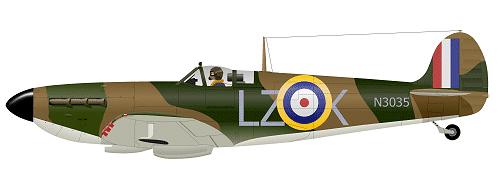Gallery No 18 - Supermarine Spitfire
Aircraft - 4 Images
My thanks to Roger Dunn and the MOD for supplying these images, Wikipedia for text.
| The Supermarine Spitfire was one of the best fighter aircraft of its
time. Unlike its counterpart, the Hawker Hurricane, it appeared to have
immense room for future improvement. This would lead to 24 marks of Spitfire
being produced throughout the Second World War in continuing efforts to
keep up with the Luftwaffe and Royal Air Force requirements.
In total there were 24 marks of Spitfire and many sub-variants within each mark. This article presents a brief history of the Spitfire through all its variants. It should be noted that the numbering of the variants does not necessarily imply a chronological order; for example, the Mk. IX was a stop gap measure brought into production before the marks VII and VIII to address the urgent needs of the air force which could not wait for the more ambitious designs of the preceding marks. It is sometimes difficult to identify the variant of an individual Spitfire as many aircraft were built as one variant and later modified to be like another variant. There is an apparent discrepancy in Spitfire numbering schemes in that
sometimes Roman numerals are used and sometimes Arabic numerals are
used. This is down to changes in RAF numbering schemes. Up until the
end of 1942 the RAF would always use Roman numerals for mark numbers.
From 1943 to 1948 was a transition period during which new aircraft
entering service were given Arabic mark numbers but older aircraft retained
their Roman numerals. From 1948 onwards Arabic numerals were used exclusively.
This article adopts the convention of using Roman numerals for the marks
I through XVI and Arabic numerals for the marks 17 through 24. Description |
.Some aircraft may appear identical but there are differences which will not be discernible from the image.
(Be patient with loading)
 |
66 Squadron Mk2 |
 |
72 Squadron |
 |
616 Squadron Mk2 |
 |
Serial #: PS915
|
(Be patient with loading)